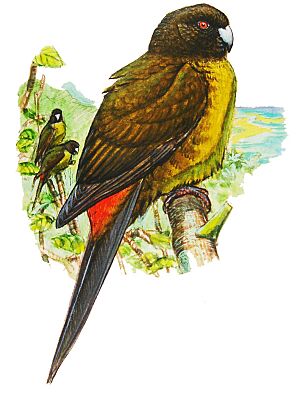Raiatea parakeet facts for kids
Quick facts for kids Raiatea parakeet |
|
|---|---|
 |
|
| Conservation status | |
| Scientific classification | |
| Genus: |
Cyanoramphus
|
| Species: |
ulietanus
|
| Synonyms | |
|
Psittacus ulietanus J. F. Gmelin, 1789 |
|
The Raiatea parakeet was a type of bird called a parakeet. It was also known as the Society parakeet, Society kakariki, or brown-headed parakeet. Sadly, this bird is now extinct, meaning it no longer exists anywhere in the world. Its scientific name was Cyanoramphus ulietanus.
What Did It Look Like?
The Raiatea parakeet was about 25 centimeters (or 10 inches) long. Its head was a chocolate brown color. This brown became lighter on its neck, rump, and wings. Its beak was a pale bluish-grey with a black tip.
The feathers on its lower back and under its tail were a reddish-brown. The feathers under its wings and on the outer parts of its flight feathers were grayish-blue. Its chest, belly, and the feathers under its tail were olive yellow.
The middle tail feathers were olive brown, and the outer ones were grey. Adult birds had orange-red eyes, while younger birds had brown eyes. Their feet were grayish-brown. Male and female Raiatea parakeets looked very similar.
Where Did It Live?
The Raiatea parakeet lived only on Raiatea island. Raiatea is the second largest island in the Society Islands. This parakeet likely lived in the forests there, as that was its natural home.
Why Did It Disappear?
The Raiatea parakeet is thought to have become extinct soon after it was first discovered in 1773. Several things likely caused its disappearance. These include losing its forest home because of trees being cut down. Hunting by people also played a role. Finally, new animals brought to the island, called invasive species, might have harmed the parakeets.
Today, only two museum specimens of the Raiatea parakeet are known to exist. These rare specimens are kept in the Natural History Museum in London and the Naturhistorisches Museum in Vienna. Scientists believe they were collected in November 1777 during the third voyage of James Cook.


